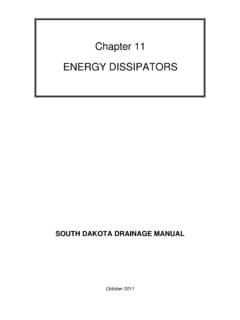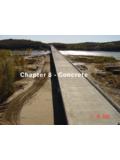Transcription of Chapter 18 HYDRAULIC SOFTWARE - South Dakota …
1 Chapter 18. HYDRAULIC SOFTWARE . South Dakota DRAINAGE MANUAL. October 2011. South Dakota Drainage Manual HYDRAULIC SOFTWARE Table of Contents Section Page OVERVIEW ..18-1. Introduction ..18-1. Chapter Content ..18-2. Coordination with Drainage Manual ..18-2. SOFTWARE ..18-3. Hydrology ..18-3. Gaged Streams ..18-3. Ungaged Streams ..18-4. Channels ..18-7. Steady, Uniform Flow ..18-7. Gradually Varied Flow ..18-7. Culverts ..18-10. Storm Drainage Systems ..18-12. Storage Stream Stability ..18-16. Bridge Hydraulics ..18-18. 1-D Bridge Hydraulics ..18-18. 2-D Bridge Hydraulics ..18-18. Bank Protection ..18-20. REFERENCES ..18-21. 18-i South Dakota Drainage Manual HYDRAULIC SOFTWARE List of Figures Figure Page Figure FLOOD FREQUENCY ANALYSIS BASED ON BULLETIN 17B .. 18-4. Figure SOFTWARE FOR UNGAGED WATERSHEDS .. 18-5. Figure SOFTWARE FOR CALCULATING STEADY, UNIFORM FLOW.
2 18-8. Figure SOFTWARE FOR STEADY, GRADUALLY VARIED FLOW .. 18-9. Figure CULVERT DESIGN SOFTWARE .. 18-11. Figure SOFTWARE FOR DESIGNING STORM DRAINS .. 18-12. Figure SOFTWARE FOR RESERVOIR ROUTING .. 18-15. Figure SOFTWARE FOR ASSESSING STREAM STABILITY .. 18-17. Figure 1-D BRIDGE DESIGN SOFTWARE .. 18-19. Figure 2-D BRIDGE DESIGN SOFTWARE .. 18-19. Figure SOFTWARE FOR BANK PROTECTION .. 18-20. 18-ii South Dakota Drainage Manual HYDRAULIC SOFTWARE Chapter 18. HYDRAULIC SOFTWARE . OVERVIEW. Introduction SDDOT uses a variety of computer SOFTWARE for hydrologic/ HYDRAULIC analysis and design. The benefits of using SOFTWARE include the capability of quickly analyzing several alternative designs, of reducing the probability of mathematical errors and of saving time by avoiding laborious hand calculations. However, the user of any computer SOFTWARE should consider the following: 1.
3 Understand the Principles Behind the Analysis Method. This understanding is essential to adequately discern whether the SOFTWARE provides an appropriate method of evaluating a problem. Engineering judgment and experience are often critical to this understanding. 2. Choose Inputs that are Consistent with Site Conditions. This usually requires thorough and careful field exploration and sometimes laboratory testing programs. Computer SOFTWARE provides the designer with efficient tools for conducting parametric analyses and for evaluating uncertainties associated with input parameters. 3. Select Geometries and Boundary Conditions that are Representative of the Field Condition. For example, each channel cross section should contain the calculated highwater elevation. If this is not the case, the model may provide an unconservative result. 4. Validate Results Using Simple Analytical or Empirical Checks or Alternate Analyses Methods.
4 Sometimes, validations can be made using simpler geometries or conditions to confirm that the analysis is reasonable. Often, a simple hand calculation can be used to confirm whether the results are reasonable. 5. Obtain an Independent Review of the Results by Another Knowledgeable Person. This review should confirm the reasonableness of the problem being modeled, and the validity of the input information. 6. Ensure the Appropriate Units are Used in the SOFTWARE . Review the SOFTWARE manual to ensure that the unit of measurement ( , in vs. ft, US Customary vs. metric) used is consistent with the input values. 7. Use Appropriate Number of Significant Digits when Presenting Results. Results from computer analyses can be obtained with several decimal points of accuracy. 18-1. South Dakota Drainage Manual HYDRAULIC SOFTWARE However, the uncertainty of input information usually does not justify this level of accuracy.
5 In reports, present the results of the computer analyses to appropriate significant digits. Chapter Content This Chapter includes HYDRAULIC SOFTWARE that is acceptable for use by SDDOT for drainage design applications. The Chapter provides a brief description of the application and function of the SOFTWARE that can be used for: estimating runoff (hydrology), Section ;. evaluating channels, Section ;. designing culverts, Section ;. designing storm drainage systems, Section ;. designing storage facilities, Section ;. assessing stream stability, Section ;. designing bridge waterway openings, Section ; and designing bank protection, Section Other SOFTWARE may be used if the methodology used with the SOFTWARE is consistent with the procedures in this Manual, and if acceptable to SDDOT. Contact the SDDOT. Bridge HYDRAULIC Engineer for approval. Coordination with Drainage Manual Throughout the South Dakota Drainage Manual, the text identifies, where applicable, any computer SOFTWARE that may be used for a specific drainage appurtenance, or the text references the applicable section in Chapter 18.
6 For example, Chapter 10. Culverts references the use of HY-8, FHWA Culvert Analysis Program for the HYDRAULIC design of culverts. 18-2. South Dakota Drainage Manual HYDRAULIC SOFTWARE SOFTWARE . The SOFTWARE is grouped by Manual chapters. The SOFTWARE version that was available when the Manual was prepared is included. For current versions of SOFTWARE and SOFTWARE documentation, the designer should consult the following web sites: FHWA;. USGS SOFTWARE ;. USGS Stream Stats;. USACE, HEC;. USACE, CHL;. NRCS;. USBR; and NDOR. User's and reference manuals are indicated with the SOFTWARE source and listed in the references. However, many SOFTWARE developers provide extensive help within the SOFTWARE in place of a user's manual ( , WMS, SMS, HY-8). Hydrology Computer SOFTWARE is available for estimating the discharge for a given design frequency event from watersheds that are gaged or ungaged.
7 Chapter 7 Hydrology . provides background information on the procedures used within these SOFTWARE programs. Gaged Streams The PeakFQ program (see Figure ) is used to analyze a continuous series of annual peak discharges so that the discharge for the design frequency can be obtained. The SOFTWARE reads annual peaks in the WATSTORE standard format and in the Watershed Data Management (WDM) format. Annual peak flows are available from NWISWeb. (Retrieve data in the WATSTORE standard format, not the tab-separated format). The StreamStats website, which is under development, will simplify this process. 18-3. South Dakota Drainage Manual HYDRAULIC SOFTWARE SOFTWARE Features Source Name PeakFQ Program PeakFQ provides estimates of USGS website instantaneous annual-maximum peak flows for a (References (1), range of recurrence intervals, including , 2, , 5, 10, 25, 50, 100, 200, and 500 years (annual- (2) and (3)).)
8 Exceedance probabilities of , , , , , , , , and , respectively). The Pearson Type III frequency distribution is fit to the logarithms of instantaneous annual peak flows following Bulletin 17B guidelines of the Interagency Advisory Committee on Water Data. The parameters of the Pearson Type III. frequency curve are estimated by the logarithmic sample moments ( , mean, standard deviation, coefficient of skewness) with adjustments for low outliers, high outliers, historic peaks and generalized skew. StreamStats StreamStats makes streamflow statistics for gaged USGS website sites available without the need to locate, obtain (Reference (4)). and read the publications in which they were originally provided. Examples of streamflow statistics that can be provided by StreamStats include the 100-year flood, the mean annual flow and the 7-day, 10-year low flow.
9 Examples of basin characteristics include the drainage area, stream slope, mean annual precipitation and percentage of forested area. Basin characteristics are the physical factors that control delivery of water to a point on a stream. StreamStats is undergoing development for South Dakota . Figure FLOOD FREQUENCY ANALYSIS BASED ON BULLETIN 17B. Ungaged Streams The primary SOFTWARE for estimating peak discharge for ungaged streams is the USGS. National Streamflow Statistics (NSS) SOFTWARE ; see Figure Similar SOFTWARE based on the National Flood Frequency (NFF) is also available in the Watershed Management System (WMS) SOFTWARE ; see Figure If a hydrograph is needed, WMS can be used to generate a hydrograph using either the HEC-HMS or TR-20/TR- 55 procedures. These procedures can also be used directly; see Figure 18-4. South Dakota Drainage Manual HYDRAULIC SOFTWARE SOFTWARE Features Source Name NFF The USGS published peak flow regression USGS website equations for every State were first compiled into the (Reference (5)).
10 NFF SOFTWARE that was last updated in 2004. The functionality of the SOFTWARE has been incorporated into the USGS NSS SOFTWARE and WMS. NSS The NSS SOFTWARE developed by the USGS contains USGS website peak flow regression equations for every State (Reference (7)). (Reference (6)). The SOFTWARE can be used to: obtain estimates of flood frequencies for sites in rural (non-regulated) ungaged basins, obtain estimates of flood frequencies for sites in urbanized basins, estimate maximum floods based on envelope curves developed by Crippen and Bue (1977), create hydrographs of estimated floods for sites in rural or urban basins and manipulate the appearance of the graphs, and create flood-frequency curves for sites in rural or urban basins and manipulate the appearance of the curves. WMS The Watershed Modeling System (WMS) is a Aquaveo website comprehensive graphical modeling environment for (Reference (8)).












